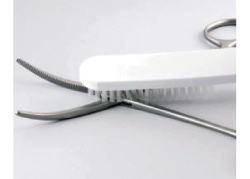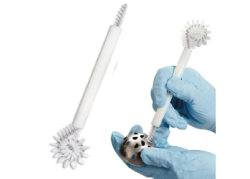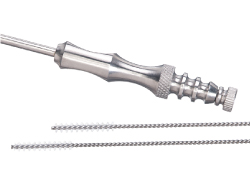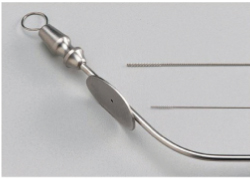How to clean surgical instruments & equipment
Proper care of surgical instruments begins with proper cleaning and consistent maintenance. Surgical instruments that require cleaning is decontaminated scissors, needleholders, forceps, cutters, cannulas, retractors, osteotomes, rongeurs, chisels, knives and any other instrument used in the operating theatre or ward.
Surgical residues such as blood, pus and other secretions contain chloride ions which lead to corrosion most often appearing as dark spots. If blood is left on the instruments for any period of time (20 minutes or longer), the instrument will mark and stain, especially if these residues are allowed to dry. Therefore, always clean and dry every instrument thoroughly after use before sterilising.
The washing process should begin within 20 minutes after surgery, even if sterilisation will take place much later. Washing instruments within a few minutes of surgery prevents blood from drying and is your best defense against corrosion, pitting and staining.
All surgical instruments must be sterilized prior to surgery to prevent infection. But even sterilization can leave contaminants behind if not properly cleaned. Sterilize instruments with the ratchets open. This allows for better steam penetration. Plus, it prevents the box locks (hinge area) from cracking.
Which cleaning brush should i use?
There are many types and styles of cleaning brushes for sterilisation departments.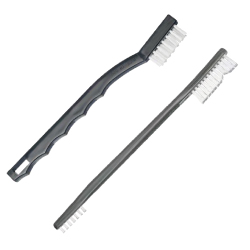
The general use/all purpose brushes are used to clean scissors, forceps, hemostats, needle holders.
These tooth brush style brushes are easy to hold and manoeuvre around the instrument. Ensure ring style instruments are cleaned with the ratchets and tips open and these areas inspected.
For cannulas, a long, flexible cleaning brush is required. The diameter of the cannula is required so the correctly sized diameter flexible cleaning brush is used. These are threaded through the cannula to clean the shaft along the inside as the brush is pull through. There are different types of cannula tips that are used for different purposes. The flexible cannula cleaning brushes can have single end, double end or bristles down the length of the shaft. They can also have plastic or wire shafts.
For shallow cannulas, shorter cleaning brushes with plastic handles can be used to clean the inside of the shaft or around the outside of the cannula.

For cleaning the hinges/ box locks of scissors, needle holders, hemotatic forceps and other ring handle instruments, a box lock cleaning brush can be used. The short bristles and large wide handle allows precise movement over the screw.
Orthopaedic reamers should be cleaned with a double ended circular nylon bristle cleaning brush. This allows the bristles of the brush to be inserted into the holes of the reamer as well as the rounded surface scrubbed in all areas. Bone reamers can also be cleaned with a hard steel rod cleaning brush which cleans the inner channel of flexible bone reamers.
Suction devices including the Baron suction tube and Frazier suction tubes/cannulas can be cleaning with very fine nylon bristle flexible brushes. These suction tube cleaning brushes are so delicate they are as small as 1mm diameter. This allows the inside of the suction tubes to be cleaned efficiently by pulling the entire cleaning brush through the suction device so that it enters and exits in one pull through.
Can cleaning brushes be reused and sterilised?
Most of the NSC cleaning brushes are reusable, unless identified as single use (usually the cannula flexible cleaning brushes). Most brushes and tip protectors are autoclavable at 134°C. There are two brushes that definitely cannot be put through the autoclave. They are the M-16SS and the 45-918. All the rest of the brushes can be sterilised. These can’t be sterilised due to the heat from the stainless steel bristles (because steel is such a great conductor of heat) causes the plastic to melt and the bristles then fall out.
Once brushes are rinsed and sterilised, do not rest them on their bristles. Hanging racks are available which can safely hold cleaning brushes whilst not in use.
What do i look for when inspecting instruments?
Surgical instruments should be inspected during the cleaning and sterilisation process.
- Inspect tips and blades of scissors, forceps etc for burrs
- Inspect jaws for damage and bioburden
- Inspect both sides of instruments for cracks
- Open and close the handles to test for smooth movement
- Use special material to test the sharpness of scissors
- Inspect needle holders for cracks or missing inserts at tips
- Inspect for dents or bending of shafts
- Ensure teeth of instrument are present with no chips
- Inspect screws/box locks for cracks, blood or residue
Ask us for a detailed manual on cleaning surgical instruments or why not get the “World of Surgical Instruments” illustrated guidebook which provides a step-by-step approach for ease of comprehension, inspection points, sharpness testing, and measuring.



